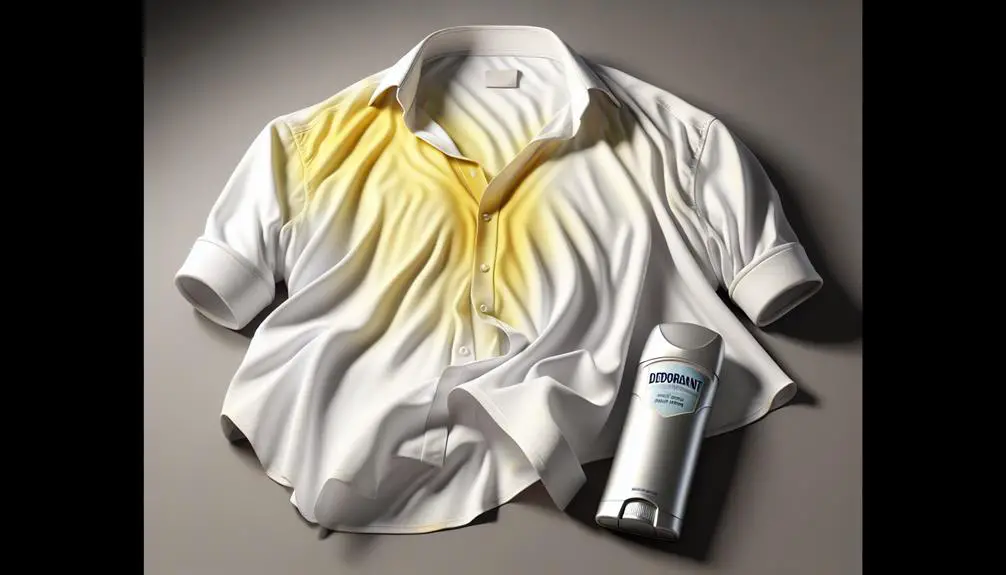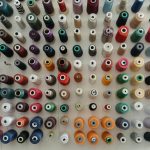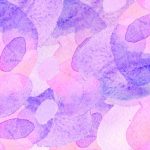I remember the frustration of finding a favorite white shirt marred by mysterious yellow stains, seemingly appearing out of nowhere. It's a common dilemma that many of us face, and those stubborn marks can be quite perplexing.
While some might attribute it to aging or wear and tear, the truth is, there are a variety of culprits behind these pesky discolorations. From sweat and body oils to bleach reactions and improper washing techniques, the causes can be as diverse as they are unexpected.
So, what really causes those yellow stains on white clothes? Let's unravel the mystery together.
Table of Contents
Key Takeaways
- Sweat, body oils, deodorant residue, and hard water deposits contribute to yellow stains on white clothes.
- Sunscreen, lotions, food, and beverages can also lead to stubborn yellow marks on fabrics.
- Using preventive measures like color-safe bleach and optical brighteners helps maintain white clothing.
- Common laundry care mistakes, like incorrect washing techniques and overloading machines, can worsen yellow stains.
Sweat and Body Oils
Sweat and body oils can often be the culprits behind those stubborn yellow stains on your white clothes. Different fabric types react to sweat and body oils in various ways. Natural fibers like cotton and linen are more prone to yellowing due to their porous nature, which allows the oils to penetrate deeply. On the other hand, synthetic fabrics like polyester may repel oils initially, but over time, they can still cause discoloration if not properly cleaned.
When it comes to tackling these stains, understanding proper laundry care is essential. Always check the care label on your clothes for specific instructions. Generally, using a pre-treatment stain remover or a mixture of vinegar and water before washing can help break down the oils. Additionally, washing white clothes in the hottest water safe for the fabric can help dissolve the oils and prevent yellowing. Remember, prompt attention to stains and following the recommended care instructions can go a long way in keeping your whites looking fresh and clean.
Deodorant Residue
After a long day, one common culprit for yellow stains on white clothes is often the residue left behind by deodorant. Deodorant residue buildup can be a nuisance, causing fabric discoloration over time.
Here are some insights into how this happens:
- Application: When deodorant is applied, some of it doesn't fully absorb into the skin and instead transfers onto clothing fibers.
- Friction: Throughout the day, as we move, the deodorant residue rubs against the fabric, leading to a gradual buildup.
- Chemical Reaction: The chemicals in deodorant can react with sweat and body oils, exacerbating the staining process.
- Heat: Heat from our bodies can accelerate the discoloration process, setting the stains further into the fabric.
To prevent these yellow stains, consider allowing deodorant to dry completely before dressing, choosing residue-free formulas, and washing clothes promptly after wear.
Hard Water Deposits
As I inspect the yellow stains on my white clothes, another common culprit to ponder is the presence of hard water deposits. Hard water contains high levels of minerals like calcium and magnesium. When this water interacts with soap or detergent during the laundry process, it can lead to mineral buildup on fabrics, causing fabric discoloration.
These mineral deposits can embed themselves into the fibers of the clothing, especially in areas where water tends to pool or accumulate during the washing cycle. Over time, these deposits can give white clothes a dingy yellow appearance that's challenging to remove with regular washing.
To tackle this issue, consider using a water softener in your laundry routine to reduce the mineral content in the water. Additionally, using a laundry detergent specifically designed for hard water can help prevent mineral buildup on your clothes. By taking these steps, you can effectively combat the effects of hard water deposits and keep your white clothes looking bright and clean.
Sunscreen and Lotions
Wearing sunscreen and lotions can sometimes contribute to the appearance of yellow stains on white clothes due to certain ingredients in these products. When these substances come into contact with fabric, chemical reactions can occur, leading to discoloration.
Here are some key points to keep in mind to prevent this issue:
- Choose Wisely: Opt for sunscreen and lotions that are labeled as non-staining or specifically designed for white clothing to reduce the risk of yellowing.
- Wait Before Dressing: Allow sufficient time for the sunscreen or lotion to be fully absorbed into your skin before getting dressed to minimize transfer onto your clothes.
- Apply Carefully: Be mindful when applying these products to avoid excessive contact with clothing, especially light-colored items.
- Check Fabric Compatibility: Some fabrics are more prone to staining, so check the compatibility of the sunscreen or lotion with your clothes before use.
Food and Beverages
When enjoying meals or beverages, it's crucial to be mindful of how they can potentially lead to yellow stains on white clothes. Wine spills and coffee stains are common culprits for causing these stubborn marks.
Wine, especially red wine, contains pigments that can seep into the fabric of your clothing, leaving behind unsightly yellow spots if not treated promptly. The tannins in wine can bind to the fibers of the fabric, making the stains difficult to remove.
Similarly, coffee stains can also leave yellow marks on white clothes. The dark color of coffee, along with its acidity, can penetrate the fabric and create stubborn stains that may require some extra effort to get rid of completely.
To prevent these stains from setting in, it's crucial to act fast. Blot the stain with a clean cloth to absorb as much of the liquid as possible, then treat it with a stain remover or a mixture of vinegar and water before laundering as usual. Remember, a little caution during mealtime can go a long way in keeping your white clothes stain-free.
Bleach Reaction
Upon contact with bleach, white clothes can develop yellow stains due to a chemical reaction that occurs between the bleach and certain substances present on the fabric. It's fascinating how simple household items can lead to fabric discoloration. Here's a breakdown of what happens when bleach meets your white clothes:
- Oxidation: Bleach is a powerful oxidizing agent. When it comes into contact with substances like body oils or sweat on your clothes, it oxidizes these compounds, leading to the formation of yellow stains.
- Chlorine Gas Release: In the presence of certain organic materials, bleach can release chlorine gas. This gas can react with the fabric, causing yellowing as a result of chemical reactions.
- Protein Interaction: Protein-based stains, such as those from sweat or food, can undergo chemical reactions with bleach. These reactions can alter the fabric's color, manifesting as yellow stains.
- UV Light Sensitivity: Some fabrics are sensitive to UV light. When bleach-treated clothes are exposed to sunlight, the chemical residues left behind can react with UV light, further enhancing the yellow discoloration.
Incorrect Washing Techniques
So, let's talk about why those yellow stains might be showing up on your favorite white clothes.
First off, using the wrong detergent can actually contribute to those unsightly marks.
Also, be careful with washing in hot water; it can cause whites to fade and turn yellow.
And finally, overloading your washing machine mightn't give your clothes the proper cleaning they need, leading to those pesky stains.
Wrong Detergent Selection
Selecting the right detergent is important for preventing yellow stains on white clothes. When it comes to wrong detergent selection, it can lead to fabric care issues and laundering mistakes that contribute to those pesky yellow marks. Here are a few key points to keep in mind:
- Check for pH Balance: Opt for detergents with a neutral pH to avoid chemical reactions that cause yellowing.
- Avoid Bleach Overuse: Excessive use of bleach can weaken fabric fibers, making them prone to yellowing.
- Use Color-safe Bleach: If you need to use bleach, choose a color-safe option to protect your whites.
- Look for Detergents with Optical Brighteners: These detergents help maintain the brightness of white clothes without causing yellow stains.
Hot Water Fading
When washing white clothes in hot water, be cautious as it can lead to fading due to incorrect washing techniques. Proper fabric care and laundry maintenance are essential to preserve the brightness of white clothes. Here are some tips to prevent hot water fading:
| Incorrect Washing Techniques | Effects | Prevention |
|---|---|---|
| Washing in hot water | Fading of fabric color | Use cold water or follow care labels for temperature |
| Overloading the washing machine | Uneven cleaning | Follow machine capacity guidelines and wash in batches |
| Using too much detergent | Residue buildup | Measure detergent correctly and use as directed |
| Skipping fabric softener | Rough texture and wrinkles | Add fabric softener during the rinse cycle |
Overloading Washing Machine
Overloading your washing machine can lead to uneven cleaning of your white clothes, affecting their overall appearance and cleanliness. When you stuff too many items into the machine, the water level may not be sufficient to thoroughly clean all the clothes. This can result in some items not getting properly washed, leading to stains or discoloration.
Also, different fabric types require specific care, and overloading the machine with various fabrics can cause damage. Here's why overloading is a bad idea:
- Water Level: Insufficient water can't reach all clothes.
- Fabric Type: Different fabrics need specific care.
- Uneven Cleaning: Overloading leads to some clothes not getting clean.
- Potential Damage: Mixing different fabric types can cause damage.
Storage in Humid Environment
After spending time in a humid environment, white clothes may develop yellow stains due to moisture interacting with the fabric. When clothes are stored in a place with high humidity, like a damp basement or a poorly ventilated closet, mold growth becomes a common issue. The moisture in the air can penetrate the fibers of the fabric, creating a perfect environment for mold spores to settle and thrive. As mold grows on the fabric, it can lead to fabric discoloration, resulting in those pesky yellow stains we see on our white clothes.
To prevent this from happening, it's vital to store your clothes in a dry and well-ventilated area. Using dehumidifiers or silica gel packets in your storage space can help reduce excess moisture in the air and inhibit mold growth. Additionally, make sure your clothes are completely dry before storing them, as dampness only exacerbates the problem. By taking these precautions, you can keep your white clothes looking fresh and stain-free, even in humid environments.
Age and Deterioration
As clothes age, they naturally undergo deterioration, which can contribute to the development of yellow stains on white fabrics. This process happens over time due to various factors, including fabric quality and exposure to sunlight. Here are some key points to help you understand how age and deterioration can lead to yellow stains on your white clothes:
- Fabric Quality: Lower quality fabrics tend to break down faster, leading to a higher likelihood of yellowing. Fabrics like polyester blends may deteriorate more quickly than higher quality natural fibers like cotton or linen.
- Sun Exposure: Excessive exposure to sunlight can weaken the fabric's fibers, making them more prone to yellowing. This is especially common in white clothes that are frequently hung out to dry in direct sunlight.
- Chemical Reactions: As fabrics age, they may react with chemicals in detergents or other cleaning products, causing yellow discoloration over time.
- Friction and Wear: The constant rubbing of fabric against itself or other surfaces during wear and washing can accelerate the aging process, leading to yellow stains.
Frequently Asked Questions
Can Using a Different Laundry Detergent Help Prevent Yellow Stains on White Clothes?
Using a different laundry detergent can help prevent yellow stains on white clothes. Laundry techniques and fabric choices matter too. I've found that switching detergents can make a noticeable difference in keeping whites bright.
How Can I Remove Yellow Stains From White Clothes That Have Already Set In?
To remove yellow stains from white clothes, I recommend trying a lemon juice treatment or vinegar soak. Additionally, using a baking soda paste or hydrogen peroxide solution can help lift the stains effectively.
Are There Any Natural Remedies for Removing Yellow Stains From White Clothes?
Sure, when it comes to natural remedies for removing yellow stains from white clothes, I swear by a lemon juice treatment or a vinegar soak. Baking soda paste and a bit of sunlight exposure also work wonders!
Can Yellow Stains on White Clothes Be a Sign of a Health Issue?
Yellow stains on white clothes can indicate health implications like sweat or body oils reacting with fabric. Prevention methods include proper washing and avoiding harsh chemicals. Color psychology suggests yellow as energetic. Different fabric types may react differently to stains.
Are There Any Specific Fabrics That Are More Prone to Yellow Stains Than Others?
Certain fabric types, like cotton or polyester, can be more prone to yellow stains due to their absorbent nature. Color fastness and stain resistance vary across fabrics, affecting how easily stains set in.
- Tetron Fabric for Marine Applications: Durability and Use Cases - June 18, 2025
- Tetron Fabric for Outdoor Furniture: Weather Resistance and Care - June 18, 2025
- Tetron Fabric for Wall Coverings: Style and Application Tips - June 18, 2025







